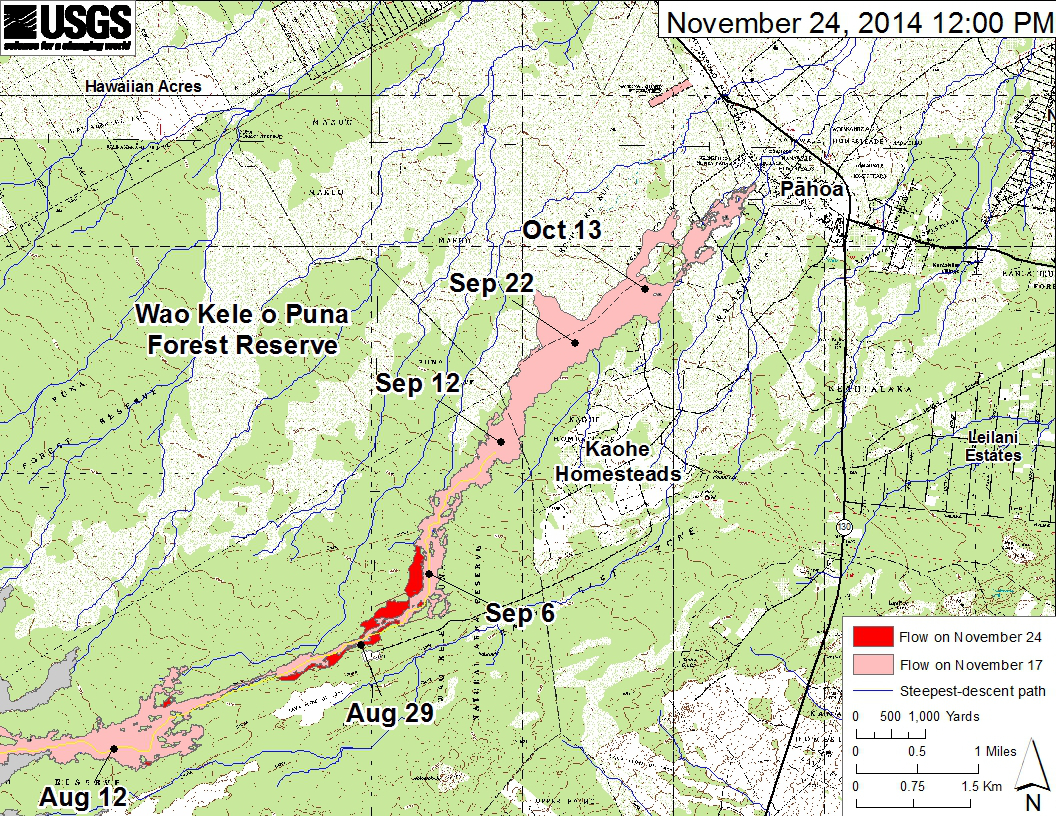(ABOVE PHOTO) This USGS Hawaiian Volcano Observatory view provides a vertical view of the lava flow in the area of ground cracks. “Portions of the flow surface include numerous downed trees,” scientists write, “resulting from the initial phases of the flow burning through the trunks, causing the trees to topple. Other areas of the lava flow are devoid of downed trees, and show areas where a second, or third, phase of lava burned through the downed trees on the initial flow surface.”
NEWS BRIEFS
- Weather condition prevented an upslope assessment of the lava flow by civil defense this morning. On Monday, the flow field was active upslope, with the nearest breakout to Pahoa measured at 3.5 miles away from Apa’a Street, having advanced 150 yards since the day before.
- The Federal Emergency Management Agency is reminding Hawaii Island that “the deadline for state, county, and certain private, non-profit organizations with eligible costs for the Pu‘u ‘Ō‘ō lava flow to submit applications” for the FEMA Public Assistance program is Wednesday, Dec. 3, 2014.
INSIGHTS
Here is audio from the Monday media conference call with civil defense, USGS and FEMA.
RECENT RELATED VIDEO
PRIMARY SOURCES

This morning’s assessment was not possible due to weather conditions. A survey and assessment will be conducted later this morning when conditions improve. Yesterday’s assessment showed that the upslope breakouts remained active. The breakouts were located approximately 3.5 miles upslope of the Apa’a Street area and consisted of surface breakouts and breakouts along the edges or margins of the flow pad. The active and most downslope breakout had advanced approximately 150 yards, and was located approximately 3.5 miles up slope of the Apa’a street area. All breakout activity did not pose an immediate threat to area communities. Residents in the down slope areas will be kept informed of any changes and the flow status and advancement.
Additional updates will be posted as conditions change.Hawaii County Civil Defense on Nov. 25 at 8:45 a.m. HST

Kīlauea Volcano continues to erupt at its summit and within its East Rift Zone. Breakouts remain active in the upper part of the June 27th flow field and around the crack system near the abandoned geothermal well site. As of yesterday afternoon, the leading edge of the lowermost breakout was on the north and west margins of the earlier flow (now inactive), located about 5.7 km (3.5 mi) southwest of the transfer station on Apa`a St. Kīlauea’s summit tilt has shown an overall deflationary trend in the past day. The level of the summit lava lake at Halemaʻumaʻu Crater lowered slightly in the past 24 hours.
June 27th Lava Flow Observations: The lowermost breakouts from the crack system in and adjacent to the abandoned geothermal well site remain active. Since the breakouts from this part of the crack system started on November 19, the lava has moved 1.7 km (1 mi) downslope along the north and west margin of the original June 27th flow. As of yesterday afternoon, this new lobe was 5.7 km (3.5 mi) southwest of the transfer station on Apa`a St. Smaller breakouts were also active about 3.5 and 5.3 km (2.2 and 3.3 mi) downslope of Puʻu ʻŌʻō. The next HVO overflight is scheduled for Friday afternoon, weather permitting.
Puʻu ʻŌʻō Observations: No significant changes were noted near Puʻu ʻŌʻō. Seismic tremor continued with relatively steady amplitude, and webcams revealed no strong variations in the pattern of glow from degassing vents nor the configuration of the crater floor. The tiltmeter at Puʻu ʻŌʻō showed little change in past 24 hours with no clear trend. The GPS-measured length across the cone has not changed significantly since July. The most recent measurement of sulfur dioxide emissions from the East Rift Zone was about 250 tonnes per day on November 18, 2014.
Summit Observations: During the past 24 hours the summit tiltmeter showed an overall deflationary tilt, but with a small inflationary tilt for a 4-hour period early last night; the tiltmeter has shown little change since about 6 am. The surface height of the lava lake in the Overlook vent has lowered slightly since yesterday morning. Volcanic tremor persisted at fluctuating amplitudes based on spattering activity in the lake. Small amounts of particulate material were carried aloft by the plume. Summit emissions of sulfur dioxide were measured at 4,400 tonnes/day on November 18 USGS Hawaiian Volcano Observatory on Nov. 25 at 9:16 a.m. HST

This large-scale USGS map shows the June 27th lava flow in Kīlauea’s East Rift Zone in relation to nearby Puna communities. The area of the flow on November 17, 2014, at 2:00 PM is shown in pink, while widening and advancement of the flow as mapped on November 24 at 12:00 PM is shown in red.

by Big Island Video News11:21 am
on at
STORY SUMMARY
Weather condition prevented an upslope assessment of the lava flow by civil defense this morning.